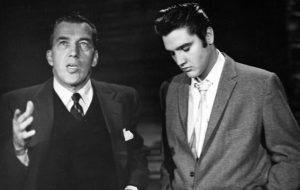
On September 9, 1956 – 63 years ago today – Elvis Presley made his first appearance, live, on The Ed Sullivan Show. (The show was indeed broadcast live in the Eastern and Central time zones, though delayed for the Mountain and Pacific time zones.) It has been suggested that this appearance on that evening 63 years ago marked the ascendance of rock ‘n’ roll as the dominant musical genre in the Western world.
Television changed everything. Yes, we all know that, but in thinking about this post I’ve realized that so ubiquitous are the screens around us that we should remind ourselves of how recent a phenomenon TV is and the degree to which it has forever changed not just our everyday lives, but our very perceptions of time, distance, shared experience, and collective memory.

Television did not become a national mass media in the United States until the mid-1950s, and it didn’t become a cultural force until the 1960s.
Between 1949 and 1969, the number of American homes with at least one television set rose from under 1 million to over 44 million. During that same period, the number of commercial television stations in the United States went from 69 to 566. Correspondingly, during this same period, advertising revenues paid to American television stations and networks increased from $58 million to $1.5 billion. The television industry – as we understand it today – wasn’t in place until the 1960s.
Since the 1960s, TV has evolved from a fairly homogeneous mass media dominated by the “big three” networks (for you youngsters, those would be ABC, CBS, and NBC) to, in the words of James Poniewozik – chief television critic for The New York Times – “the polarized, zillion-channel era of cable-news fisticuffs and reality shocker-entertainment” that it is today.

In the process of its evolution, television has, for better or worse, gone a long way towards eliminating regional cultural differences and accents (for example, we read that Johnny Carson’s Iowa/Nebraska twang became the standard “American” accent thanks to his 44-year television career).
Television has changed our sense of time and distance, in that with the advent of live TV, there is no such thing as “time” or “distance”, as we have come to expect instant updates from every corner of the globe, an expectation now fulfilled to a fault by our smart phones. Television changed forever the way we consume information and entertainment, as we have come to expect instant aural (that’s “aural” with an “a”!) and visual gratification.
Among the many earth-shaking changes it has wrought, television has given our species instant and effortless access to live events, allowing us to see and hear life-changing current events from the comfort of our homes as they happen.
In last week’s Dr. Bob Prescribes post, I mentioned that on Sunday, November 24, 1963, the 9-year-old me was among the many millions of people who saw Jack Ruby shoot (and kill) President Kennedy’s alleged assassin – Lee Harvey Oswald – in the basement of the Dallas Police Headquarters.
A crazy thing for a 9-year-old child to see live on TV. But there you have it: live television has given each of us shared access to a range of events unimaginable before the advent of TV. We all have our short list of crazy, life-changing events seen live on television. Off then top of my head – and excluding sports – here are a few of mine.

On Sunday, February 9, 1964, my family of five was among the 72 million viewers tuned to The Ed Sullivan Show to see the American “debut” of The Beatles. Speaking personally, that broadcast was my entrée to not just the Fab Four but to rock ‘n’ roll. It was – for me – a life-changing experience, one that resonates to this day.
A stupid question: was there any TV not tuned to the moon landing on July 20, 1969? I get goosebumps just writing about it. What an unbelievable and breathtaking event that was. When the lunar module touched down and Neal Armstrong said – from a quarter-million miles away – “Houston, Tranquility Base here, the Eagle has landed”, my father started to cry. Watching it just now on YouTube, I could not restrain my tears. What an incredible, shared moment that was for all of us: a live, real-time demonstration of courage, ingenuity and the human spirit at its best.
On August 8, 1974, we watched Richard Nixon deliver a 16-minute speech during which he resigned his presidency. A friend with whom I was watching said, “finally, the nightmare is over” and for a while, at least, it was.
On November 10, 1989, we watched as the first concrete slab that made up the Berlin Wall – which had stood for 10,316 days – was removed. All along the 27 miles of wall that divided East and West Berlin (another 69 miles of wall separated West Berlin from the surrounding East German countryside), people hammered and chipped away at the thing. I remember shaking my head while I watched; it was unbelievable; unimaginable; and we all witnessed it together.
As we witnessed United Airlines Flight 175 hitting the south tower of the World Trade Center at 9:03 am Eastern Time on September 11, 2001. By the time the remaining north tower collapsed at 10:28 am, an estimated 2 billion people were watching live, worldwide.
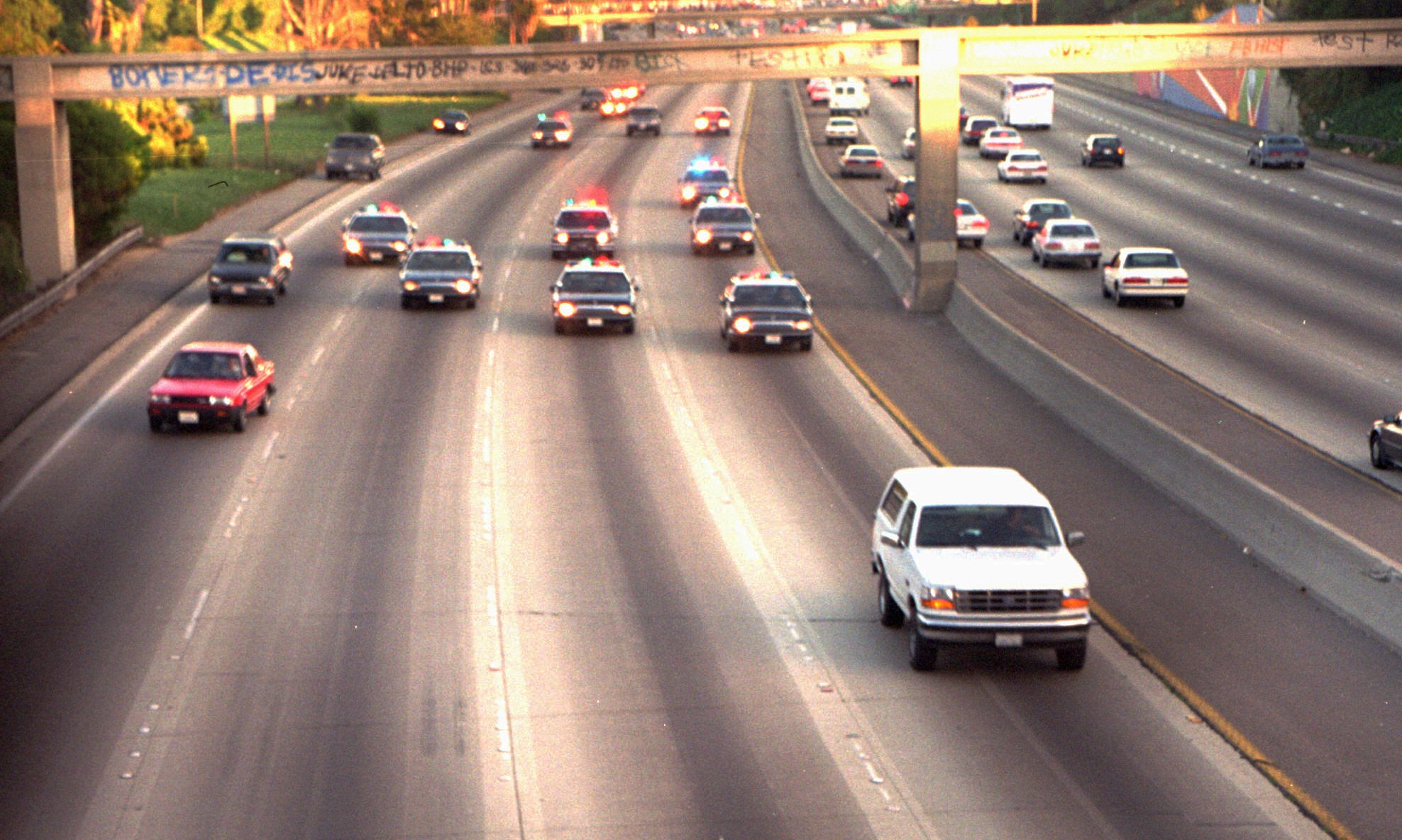
Television has allowed us to witness and, from a remove, to participate in – live – royal weddings, coronations and funerals; to observe hurricanes and floods and fires as they unfold; to be eyewitness to protests and riots; and, perhaps most idiotically of all, to watch in real time O.J. Simpson’s two-hour car chase in his white Ford Bronco across the freeways of Los Angeles, as captured by over a dozen news helicopters and broadcast live to over 95 million viewers.

It has been suggested that September 9, 1956 – 63 years ago today – “is the day that rock ‘n’ roll truly established itself as the dominant musical genre in America and therefore the Western world”; the day Elvis Presley made his first appearance on America’s most popular TV show, a variety show hosted by a former journalist and Frankenstein impersonator named Ed Sullivan.
In fact, by the time he appeared for the first time on The Ed Sullivan Show, Elvis Aaron Presley (1935-1977) had already appeared three times on national television: on the Dorsey Brothers Show, the Milton Berle Show, and the Steve Allen Show, the latter on July 1, 1956. Steve Allen did not like rock ‘n’ roll or Presley’s act, but he needed a ratings boost, as his Sunday evening show on NBC was up against Ed Sullivan’s on CBS.
Sullivan could have had Elvis first, but he didn’t like rock ‘n’ roll or Elvis’ act either. So when Elvis’ manager Colonel Tom Parker offered Sullivan a single show for $5k, Sullivan turned him down, prompting Elvis to sign on with Steve Allen.
Thanks to Presley’s appearance, Steve Allen’s ratings went through the roof, at the expense of Ed Sullivan’s ratings. Sullivan, realizing he had made a major boo-boo, signed Elvis, but at a cost: $50k for three appearances.
That first appearance took place 63 years ago today. More than sixty million people tuned in to watch, some 82% of the evening’s TV audience, a rating that dazzles us to this day.
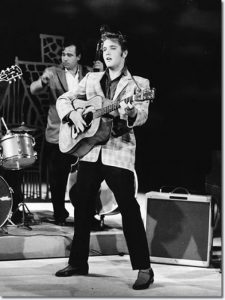
The audience saw neither Elvis nor Ed Sullivan in Sullivan’s New York Studio. Presley was in Hollywood filming his first movie and thus performed from a local CBS studio. Ed Sullivan was on medical leave, recovering from a head-on collision suffered a few weeks earlier. The Oscar-winning English actor and director Charles Laughton subbed for Ed Sullivan that evening. He introduced Elvis by saying, “Away to Hollywood to meet Elvis Presley.” The scene shifted to Elvis, wearing a plaid jacket that made him look like a used car salesman. After acknowledging that being on the Sullivan show was “probably the greatest honor I have ever had in my life,” he began his three-song mini-set with Don’t Be Cruel.
As for the oft’ told story that Presley was shown only from the waist up, so to spare the youth of American from his hip-grinding, grunt-and-groin persona, well, don’t you believe it. While the cameras stayed mainly on the top of Elvis’ body during his first number, those cameras showed him full length in his final two songs.
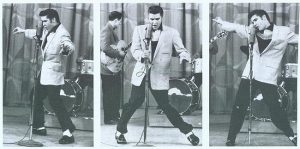
Presley’s second appearance on Ed Sullivan took place on October 28. It garnered huge ratings but set off a firestorm. Presley’s gyrating hips were in particularly fine fettle that evening, and the press had a field day, attacking both Elvis and rock ‘n’ roll for being depraved and animalistic despoilers of America’s youth. Riots took place in both Nashville and St. Louis, where Elvis was burned in effigy.
It was during Presley’s third and final appearance on Sullivan’s show in January of 1957 that he was shown only from the waist up. It has been suggested that this was done not on orders from Ed Sullivan but through the connivance of Presley’s manager, Colonel Tom Parker, who believed that by so “censoring” Elvis his sexual notoriety would only increase.
And increase – exponentially – it did. Elvis Presley’s impact on planetary culture was greater than that of any other individual during the second half of the twentieth century. His look, his manner of singing (in equal part Black American Blues, Christian gospel, and Southern country), his sexually provocative way of moving, and the intensity and abandon with which he performed are all now part of the essential iconography of the twentieth century.
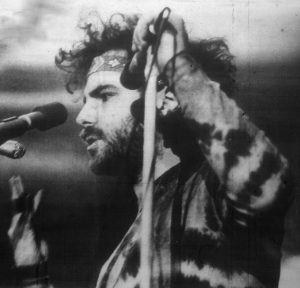
More than any other single person, it was Elvis who lit the fuse that exploded into the “sexual revolution” of the 1960s. Jerry Rubin, one of the “Chicago Seven”, wrote in his book DO IT!: Scenarios of the Revolution (of 1970):
“Elvis Presley ripped off Ike Eisenhower by turning our uptight young awakened bodies around. Hard animal rock energy beat/surged hot through us, the driving rhythm arousing repressed passions.”
Rubin’s statement addresses something that sent shudders of terror through parents everywhere. Presley represented sexual liberation, and once that genie escaped from the bottle no amount of parental or societal pressure could put it back.
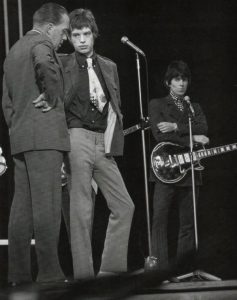
Elvis Presley’s record sales say it all: between 1956 and 1961 he had thirty-eight gold records, selling 115 million disks worldwide. Elvis made rock ‘n’ roll an international phenomenon, and he remained the dominant force in rock ‘n’ roll until the so-called British invasion of 1964, which saw, among many other groups, the arrival in North America of The Beatles and The Rolling Stones (who, for our information, made their first appearance on The Ed Sullivan Show 8 months after The Beatles, on October 25, 1964).
Join Robert Greenberg on Patreon
Listen on the Music History Monday Podcast
Podcast: Play in new window
Subscribe: Apple Podcasts | Spotify | Pandora | iHeartRadio | RSS | More
